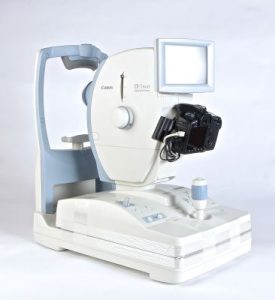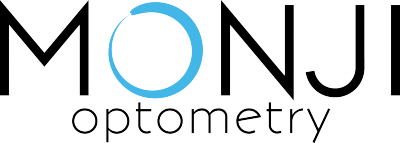Corneal Mapping
Corneal topography, also known as photokeratoscopy or videokeratography, is a non-invasive medical imaging technique for mapping the surface curvature of the cornea, the outer structure of the eye. Since the cornea is normally responsible for some 70% of the eye's refractive power, its topography is of critical importance in determining the quality of vision.
The three-dimensional map is, therefore, a valuable aid to our Burbank eye care experts, Dr. Monji and Dr. Ichiuji, and can assist in the diagnosis and treatment of a number of conditions; in planning refractive surgery such as LASIK and evaluation of its results; or in assessing the fit of contact lenses. A development of keratoscopy, corneal topography extends the measurement range from the four points a few millimeters apart that is offered by keratometry to a grid of thousands of points covering the entire cornea. The procedure is carried out in seconds and is completely painless.
Our Topcon KR-1W: The 5-in-1 KR‐1W Wavefront Analyzer boasts the combined technologies of wavefront aberration, corneal topography and auto‐refraction.
Special thanks to the EyeGlass Guide, for informational material that aided in the creation of this website. Visit the EyeGlass Guide today!
KR-1 Auto Kerato-Refractometer
The new KR-1 Auto Kerato-Refractometer features fully automated operation with an easy-to-use color touchscreen, a 360-degree rotatable monitor, and a flexible layout and space saving design. The Rotary Prism measuring system ensures fast, accurate, and repeatable refraction and keratometry measurements. The KR-1 also helps with dry eye symptoms and can analyze tear layers within seconds!
Key Features
- Flexible layout and space saving design
- 360° rotatable monitor
- The easy-to-use color touch panel
- Comfortable design for patients
- Topcon's Rotary Prism measuring system ensures stable measurement accuracy
Digital Retinal Imaging & OCT Scans
Drs. Monji and Ichiuji use cutting-edge digital imaging technology to assess your eyes. Many eye diseases, if detected at an early stage, can be treated successfully without total loss of vision. Your retinal Images will be stored electronically. This gives the eye doctor a permanent record of the condition and state of your retina.
This is very important in assisting our optometrists to detect and measure any changes to your retina each time you get your eyes examined, as many eye conditions, such as glaucoma, diabetic retinopathy, and macular degeneration are diagnosed by detecting changes over time.
The advantages of digital imaging include:
- Quick, safe, non-invasive and painless
- Provides detailed images of your retina and sub-surface of your eyes
- Provides instant, direct imaging of the form and structure of eye tissue
- Image resolution is extremely high quality
- Uses eye-safe near-infra-red light
- No patient prep required
Digital Retinal Imaging
Digital Retinal Imaging allows your eye doctor to evaluate the health of the back of your eye, the retina. It is critical to confirm the health of the retina, optic nerve, and other retinal structures. The digital camera snaps a high-resolution digital picture of your retina. This picture clearly shows the health of your eyes and is used as a baseline to track any changes in your eyes in future eye examinations.
Canon CR-1 Mark II Fundus Retinal Camera

The Canon CR-1 Mark II Fundus Digital Retinal Camera epitomizes state-of-the-art non-mydriatic imaging technology with ultra-high resolution images in an ergonomic, easy to use design. The CR-1 Mark II focuses on reducing patient stress by providing comfortable retinal exams with significantly reduced flash intensity. Because retinal exams play an important role in screening for major illnesses, the ease of examining provided by the CR-1 Mark II supports overall healthcare for people.
Key Benefits and Features:
- Low Flash Intensity
- High-Quality Retinal Imaging
- 45-Degree Angle of View
- 2X Digital Magnification
- Ergonomic Controls
- Safe, Secure Patient Positioning
- Easy Alignment and Focusing
- Retinal Imaging Control Software
- Easy Alignment and Focusing
- Printers and Projectors
Visual Field Testing
A visual field test measures the range of your peripheral or “side” vision to assess whether you have any blind spots (scotomas), peripheral vision loss or visual field abnormalities. It is a straightforward and painless test that does not involve eye drops but does involve the patient's ability to understand and follow instructions.
An initial visual field screening can be carried out by the optometrist by asking you to keep your gaze fixed on a central object, covering one eye and having you describe what you see at the periphery of your field of view. For a more comprehensive assessment, special equipment, such as our Humphrey Automated Visual Field Machine might be used to test your visual field. In one such test, you place your chin on a chin rest and look ahead. Lights are flashed on, and you have to press a button whenever you see the light. The lights are bright or dim at different stages of the test. Some of the flashes are purely to check you are concentrating. Each eye is tested separately and the entire test takes 15-45 minutes. These machines can create a computerized map out your visual field to identify if and where you have any deficiencies.
